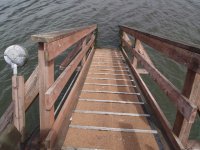It really a dock but I have to move a dock ramp where the dock washed downstream in a storm. This is at South Bend, WA on the Willapa River.
The dock ramp has been sitting submerged at one end for about a year. The other end is hinged on a walkway coming from a building. At low tide I will strap some 55 gallon drums to the submirged end of the ramp and a few more on the upper portion. When the tide comes in I will cut the hinges to let the high end of the ramp drop and tow it about 3/4 miles down river to a boat launch.
I figured I would rig a tow rope in a Y configuration. I will hook each end of the V portion to my stern cleats and the tail to the ramp. I will also attach a float where the tail and V come together to keep it out of the prop. I am not sure how long to make the tow rope but I thought each leg of the V would be 12 feet and the tail about 20 feet. There are some pilings and a log boom I will have to maneuver around to get out into the open water so I may have to shorten the tow rope for this.
I am going to time this so I am towing the ramp down stream just before high tide. I don't want to be towing down stream on an outgoing tide. When I get it to the boat launch I will have a track excavator to pull it in and load it onto the trailer.
The ramp is 8 feet at the widest part and 28 feet long and I am estimating it weighs 3500 pounds
Any body have any advice or something I should be aware of that I am missing. I will be towing with my 16/18 foot C-Dory.
_______
Dave :cigar
:cigar
The dock ramp has been sitting submerged at one end for about a year. The other end is hinged on a walkway coming from a building. At low tide I will strap some 55 gallon drums to the submirged end of the ramp and a few more on the upper portion. When the tide comes in I will cut the hinges to let the high end of the ramp drop and tow it about 3/4 miles down river to a boat launch.
I figured I would rig a tow rope in a Y configuration. I will hook each end of the V portion to my stern cleats and the tail to the ramp. I will also attach a float where the tail and V come together to keep it out of the prop. I am not sure how long to make the tow rope but I thought each leg of the V would be 12 feet and the tail about 20 feet. There are some pilings and a log boom I will have to maneuver around to get out into the open water so I may have to shorten the tow rope for this.
I am going to time this so I am towing the ramp down stream just before high tide. I don't want to be towing down stream on an outgoing tide. When I get it to the boat launch I will have a track excavator to pull it in and load it onto the trailer.
The ramp is 8 feet at the widest part and 28 feet long and I am estimating it weighs 3500 pounds
Any body have any advice or something I should be aware of that I am missing. I will be towing with my 16/18 foot C-Dory.
_______
Dave



